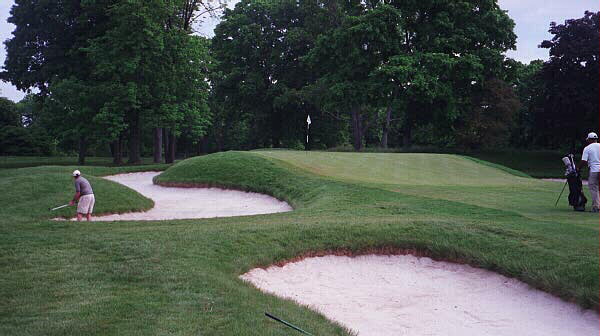Tom;
Pretty ironic!
I know the drawings you're talking about, and it's clear that the mid 1920's changes and really almost redesign of several holes at Merion are almost exactly as Flynn and Wilson envisioned them, althought it's interesting that Flynn's is the only name attached. History seems pretty clear, however, that he was working directly with Wilson, and having started his own design business by then, it's not tough to understand that he would have been the one to do the hole drawings.
Still, it also seems to be a case where the student went on to surpass his teacher, and it's important to note that Flynn had already created several great courses on his own at that point, including Lancaster!
I do have a few comments/questions re: the bunker surrounds, and I'll keep it to the finer points of architecture, less editorial commentary.
I haven't seen the bunker surrounds at Lancaster yet, but your description of "fescue surrounds" sounds beautiful visually, but potentially problematic from a playability standpoint. Depending on maintenance management of these areas, I could see where they could possibly become frustrating for a membership in terms of lost balls, etc.
I'm also not sure that I'd characterize the bunker restoration work that Gil and company did at Merion (such as the 7th and 9th) as "fescue surrounds", because I'd be concerned that I'm creating the wrong visual impression to those who didn't see it. I prefer the term "naturally integrated", which I think is more descriptive.
By that I mean that the bunker edges just sort of naturally dissolved into the next adjoining transition area. On the 9th, for instance, the greenside bunkers are bordered by "first cut" of rough, and as such, there is no fescue that acts as a border between the sand and first cut.
I'm including the picture of Gil's restoration work on that hole from this site below, by way of illustration.

If you look at Geoff Shackelford's "Golden Age" book on page 69, it's an interesting comparison. I have a picture from virtually the same place as the photographer in Geoff's book at home, and the pictures are truly identical. I will see what I can do to get that one digitized.
Contrast that approach with the picture of the righthand greenside bunkers on 7 that Tommy recently posted (his server is temporarily down, or I would have included it here), which in fact were "fescue surrounded". In that case, the bunkers are located in the rough hillside bordering that green and OB fence, and the fescue look was indicative of the severity of the trouble as well as integrated with the surrounding severe trouble on the hillside.
I think that's the reason so many of us liked them so well, and the reason they appeared so natural. In a way, they were "bunkers without borders", because of the way they transitioned so well into whatever surrounded them. In the case of Merion, those transitions included first cuts of rough, broken ground, some scraggly, raw patches, fescues, lovegrass plantings, wooded areas, etc.. They matched the inconsistency of the rest of the land perfectly.
It's also the reason that clean-cut, bluegrass sod surrounds placed around bunkers on older courses fail to achieve that same beautifully integrated look...unless, of course, everything else "off the fairway" is the same consistent bluegrass.
Simply put, that's the reason that Augusta's bunkers can look very good, as well, in my opinion. The sharp, clean look of their bunkers appeal to the eye to a great extent because their is no "break" or transition from their immediate surrounds out further....because everything flows cleanly and uninterrupted from the edge of the bunkers out to the tree lines.
In the case of Gil, I know his group loves to build rugged looking bunkers and they are truly exceptional in that regard. But, similar to the comment you heard, I understand that some memberships are not quite as appreciative of that approach as we might be, probably because the bunkers are throwbacks to another time, and certainly play effectively as hazards. Still, for people coming at the game from a modern mindset, they require a bit of an adjustment in thinking.
I wasn't aware that he had restored the bunkers at Lancaster, but had a couple of questions.
Are the bunkers at Lancaster built with "fescue surrounds" in every case, or would you describe them as more "naturally integrated", if I've explained the distinction understandably?
In watching play, was it sometimes better to be 'in the bunker' than just outside it?
Do you know if the restoration was to a certain time period in Lancaster's history? In other words, was their evidence of those type of surrounds in historical photos?
I ask, because having had the opportunity to see some of Gil's superb "restoration" efforts at places like Fenway, Plainfield, and Downingtown, he seems to be a stickler for sensitive historical detail.
Thanks again for your very interesting report!
I've included a few pics of Hanse's Tillinghast restoration of Fenway below by way of contrast, as well as two from his original course at Inniscrone that incorporates transitions to a fescue area.




